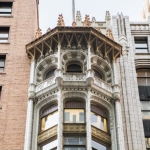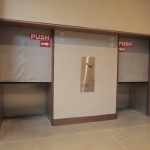Identifying Key Features of Effective Fire and Smoke Curtains
When developing a comprehensive fire safety plan for a building, it’s critical to account for the many complex, interconnected elements that could impact fire and smoke control. From the windows, doors, elevators, and stairwells to the prominent atrium in the front lobby, careful planning is required to effectively mitigate the spread of fire and smoke in the event of an emergency.
Fire and smoke curtains offer a simple, cost-effective way to manage fire and smoke in an emergency. They can be configured to fit and protect any space, making them a more affordable alternative to engineered ventilation systems.
It’s crucial to understand that different types of curtains serve different functions. When selecting the right fire and smoke curtains for your building, it’s important to consider whether your goal is to contain the fire or facilitate evacuation. This understanding will guide you in choosing the appropriate method or combination of methods.
Elevator Smoke Curtains

When selecting a smoke curtain for your elevator system, there are several important factors to consider:
- When selecting an elevator smoke curtain, ensure the dimensions – both width and height – are appropriate to fully cover the entire elevator opening for proper functionality.
- The depth or distance between the wall and the face of the elevator door frame is commonly referred to as the “return.” Certain elevator smoke curtain models have specific return requirements, so you may need to choose a customizable model to meet your needs.
- Elevator smoke curtain housings can be mounted to the door frame, ceiling, or valence. It is important to determine which mounting option is compatible with your elevators.
- Elevator smoke curtains are designed with power-failure contingencies in mind and do not require power to deploy. Most systems incorporate a battery backup to ease egress during a power outage; this can also help prevent unnecessary and disruptive deployments during minor power failures.
Fire Curtains

If you’re planning to install fire curtains, keep the following in mind:
- Fire curtains come in vertical and horizontal configurations to address different fire safety needs. Vertical curtains are installed around stairwells and escalators to facilitate occupant evacuation during a fire. Horizontal curtains are used to divide an atrium into smaller areas, which helps limit the spread of fire. Window curtains contain fires at exterior windows. In large, multi-story buildings, a combination of these various fire curtain types is often required to provide comprehensive fire safety.
- When selecting fire curtains, it’s important to consider their fire protection and endurance ratings. While we hope emergency responders can arrive quickly, the time it takes for them to control a fire may vary depending on your location and building size. To ensure adequate safety, choose fire curtains rated to withstand flames long enough for the fire department to contain the spread.
- When selecting a fire curtain system, it’s crucial to consider the space requirements for housing the curtain when not in use. Fire curtains can cover expansive areas, with Door System’s model capable of spanning spaces hundreds of feet wide.
- To ensure fire curtains can be deployed even during a building-wide power outage, they should be installed with a backup battery system. Additionally, some fire curtain systems can be connected to the building’s standby power supply. It’s crucial to properly install and power the fire curtains to guarantee they function correctly in an emergency.
- When selecting a fire curtain system, prioritize ease of operation. Fire curtains are effective at protecting evacuating building occupants, but there may be situations where a curtain needs to be opened – either to facilitate exit flow or allow more people into the stairwell. It’s important to choose a model that is simple to operate and can be quickly used by occupants during an emergency.
When selecting smoke and fire curtains for your building, be sure to understand the maintenance and testing requirements for this critical fire safety equipment. Proper care and regular checks are essential, as smoke and fire curtains play a vital role in any comprehensive fire safety plan.



